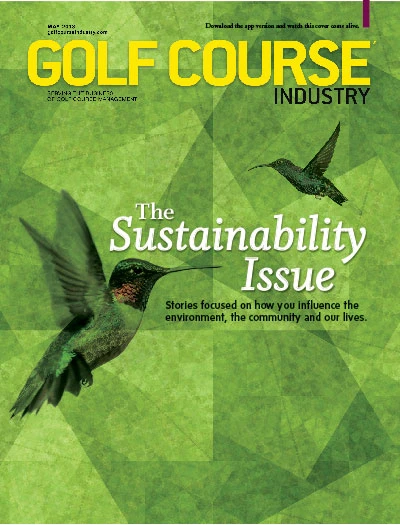 The concept of sustainability in golf has been developing over the last couple of decades. Early origins came from across the pond as the term “sustainability” was being used more frequently in the UK. While it was a slow process, the terminology and concept has slowly grown in North America to the point that a variety of organizations have embraced the concept.
The concept of sustainability in golf has been developing over the last couple of decades. Early origins came from across the pond as the term “sustainability” was being used more frequently in the UK. While it was a slow process, the terminology and concept has slowly grown in North America to the point that a variety of organizations have embraced the concept.
Most of the regional golf turf conferences have presentations that cover this subject. As golf evolves to find its “new normal” it will be important for the game and business to support sustainability.
Sustainability? Each golf course can implement sustainable natural resource management in all facets of the business. It is important to note that the concept of sustainability is not about reaching specific criteria in a short period of time but more importantly having a plan that makes progress to ensure a golf course utilizes efficient and environmentally friendly practices. Those practices are broad and several different organizations have written criteria and checklists to guide a facility through the process.
The types of initiatives should include:
- Recycling
- Use of energy renewable resources
- Utilizing environmentally friendly pest control inputs
- Irrigation management to reduce overall reduction in water usage
- Zero Waste generation
- Continuing education for staff and communication to golfers and the community
It is easy to understand that moving toward sustainability is a project that can take many years and the process is never ending. It is all about setting goals for the short, medium and long term. As science and technology advance there will always be new ways to do things more economically and efficiently. Through continued advances in science and research the bar will always move higher in creating opportunities for facilities to be environmentally friendly.
|
Reasons for sustainability
|
A good way to look at becoming sustainable is to develop a plan that may not be achievable in the short term but a plan that is carried out over time. Most certification programs have components that not only measure progress but they also ensure that each recertification period must show improved sustainability from previous years.
Zero waste. One of the most aggressive programs for sustainability is the Zero Waste Program undertaken by the Dairy Creek Golf Club operated by the County of San Luis Obispo in California. Led by, Josh Heptig, director of golf operations the goal was simply to manage all inputs on the property and achieve a goal of no waste.
As stated earlier facilities go through a process. Dairy Creek GC was no different. Their initial steps were to analyze the situation and develop a game plan. Part of that process was to find solutions and also to develop partners to collaborate with to achieve their lofty goals. San Luis Obispo County’s Integrated Waste Management Authority stepped up and provided two vessel composters to get the ball rolling. Seeing the potential at several golf courses owned by the county, a $220,000 grant from CalRecycle became a reality to provide recycling containers for all the golf facilities managed by the County of SLO. Soon after the initiation of the program a local Eco-Rotary Club joined forces with the county golf courses and assisted with volunteers who contributed time and funds to support this effort. Over several months compost bins were constructed and many hours of managing food wastes to create compost helped to make the program a success.
All materials used in the processing or consumption of foods and goods are managed with a logical flow. This would include processing food waste, recycling items like plastic, glass, cardboard, aluminum, batteries, oil, etc. The amount of material that cannot be recycled is minimal to none so it has resulted in achieving the zero waste goal.
The GEO Plan. A comprehensive program for sustainability exists with GEO. While there are others, it is easy to focus on one program and allow for a comparison to others out there such as ISC-Audubon. The first steps are to do your homework and research. Evaluate the GEO program by going to the website and take an hour or so to surf the site. At some point there will be a request to fill in some information identifying your type of facility. Once you see if you fall into the arena of golf course construction or existing golf course operations you will see what criteria is required for you to participate in advancing your efforts for sustainability and hopefully achieving certification.
 Establish an online club profile with GEO. Next, a Sustainability Statement for your facility is developed by working with GEO staff and the team at your facility. Online input continues with establishing what good things you are currently doing and then setting goals to achieve and understanding the gap in between to develop a road map for success. For certification there are minimal standards that are required but the key is to be committed to improving sustainability over time. Certification periods are three years and then the renewal process starts over again for the next three-year cycle.
Establish an online club profile with GEO. Next, a Sustainability Statement for your facility is developed by working with GEO staff and the team at your facility. Online input continues with establishing what good things you are currently doing and then setting goals to achieve and understanding the gap in between to develop a road map for success. For certification there are minimal standards that are required but the key is to be committed to improving sustainability over time. Certification periods are three years and then the renewal process starts over again for the next three-year cycle.
Eventually an on-site visit will be scheduled with a GEO sustainability associate. Those individuals appraise your application, give ideas for future improvements, factor in regional differences and write a summary. A visit takes a half day to complete. Upon completing the visit and writing a summary report the associate verifies the information, meeting of the standards and then makes a recommendation for awarding the Ecolabel.
Many facilities find value in the achievement and share that information with the golfing community in their region. They proudly display their certificate prominently. If improvement projects are a part of your plan then they will need to be scheduled and completed. By instituting previously mentioned processes it should be easy to track your results allowing a facility to qualify any expenses and to evaluate the return on investment of this program.
The right thing. At this point it may not be a requirement for any existing facility to have a plan for sustainability. However, it is often a requirement for permitting for any new golf course development. Also there are smaller components that have become requirements in various regions. If we use water reduction in drought-stricken areas, or the use of recycled water, as a requirement rather than a request it is obvious that society and government are steering us in that direction. Mandatory recycling of green waste is an adjustment that has been made at many golf courses and what was once thought as onerous is now just a normal way of doing business.
|
Who is on board? Through the Environmental Institute for Golf, GCSAA is a strong supporter of continuing education for golf course superintendents by providing the latest environmental and agronomic techniques to maintain healthy turfgrass and protect environmental resources through sustainable practices. GCSAA has members at a large percentage of golf courses in North America. Through their magazine and online presence they provide monthly information on sustainable practices. The United States Golf Association has a team of agronomists that conduct Turfgrass Advisory Visits all across North America. As a part of that process those agronomists give advice and share tips on how to develop more sustainable practices for each and every facility. Additionally the USGA has long championed the cause through both Green Section Journal articles and also through a couple decades of support and collaboration with programs like the Audubon Cooperative Sanctuary Program. The Audubon Cooperative Sanctuary Program was, and continues to be, a very positive program embraced by many golf courses. Ron Dodson has led that organization since its infancy. Just this past month Ron has stepped down from that leadership position and has now taken on a similar role with the International Sustainability Council. We can expect to hear great things from this group in the upcoming months. The ISC-Audubon mission is to foster sustainable living and lifestyles at home, work and play. They accomplish this through a number of award winning education and certification programs. The vision of ISC-Audubon is to help create a more sustainable world. They assist people and their businesses then discover and implement sustainability solutions that are reliable, practical, efficient and that reduce risk. GEO is a global Golf Environmental Organization that is based in Scotland. While the original outreach was in the UK and Europe it has expanded rapidly to the rest of the globe. GEO offers training and certification of sustainable facilities as does ISC-Audubon. GEO also has a number of allies in the industry and those include GCSAA, Royal and Ancient, CMAA, American Society of Golf Course Architects and the Golf Course Builders Association of America. Through working together the industry has several programs to choose from for your facility. Some have certification programs and all provide tips and education. Certifications have a cost and need to be considered as a part of the evolution to sustainability. It is recommended that golf facilities join these organizations and support them so that you can have a thorough evaluation of what fits best for your facility. For more information contact: |

Explore the May 2013 Issue
Check out more from this issue and find your next story to read.
Latest from Golf Course Industry
- SePRO to host webinar on plant growth regulators
- Turfco introduces riding applicator
- From the publisher’s pen: The golf guilt trip
- Bob Farren lands Carolinas GCSA highest honor
- Architect Brian Curley breaks ground on new First Tee venue
- Turfco unveils new fairway topdresser and material handler
- Ignite Attachments adds new box plane and grapple
- Mackenzie & Ebert working on new Caribbean course





